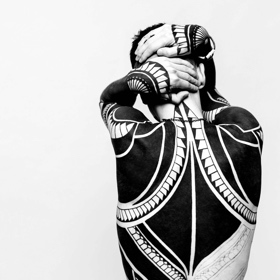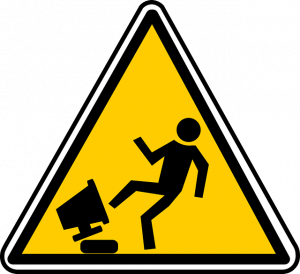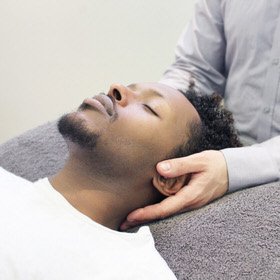Polyvagal Theory Explained
Relieving stress, anxiety and exhaustion at Shine in North London
Stephen Porges Ph.D. developed the Polyvagal Theory in the mid-1990s, describing the interaction between our body and brain.
The theory explains how our central nervous system (CNS) evolved in ways that promoted both social behaviours and defence mechanisms: mobilization, associated with fighting or fleeing, and immobilization, associated with hiding and freezing.
The vagus nerve directly supports the behaviours needed to engage and disengage with the environment.
– Dr Stephen Porges.
The vagus is a cranial nerve that exits the brainstem and travels to the organs in the body.
‘Poly’ means many and ‘vagus’ refers to the tenth cranial nerve, the vagus nerve. Vagus in Latin means ‘wandering’, since it is this nerve that has the longest pathway, linking the brain stem, neck, ears and tongue to the heart and lungs, going on into the abdomen and further down to parts of the colon. The vagus innervates many organs on its route, including the spleen, liver, gallbladder, female fertility organs and kidneys.
vagus innervates many organs on its route, including the spleen, liver, gallbladder, female fertility organs and kidneys.
Being so vast, its connections play a major role in controlling the body’s functions, from the digestion of food to the regulation of heart rate, blood glucose, blood pressure and hormones such as cortisol, which is related to states of stress. The vagus links human connection to body-sensing states in our nervous system, especially in our face, chest and belly.
The vagus is bidirectional: information from the brainstem travels to the visceral organs and vice-versa.
Our Central Nervous System is a complex highway of information pathways, all working at the same time at very high speed, assessing, modulating, contracting and releasing. Some pathways go up and down along the body from head to toe, while other parts go in circles around our organs, sending messages of alert and rest. The information that is picked up from our environment can affect the whole of this system. We can go into full states of fight, flight, freeze or ease.
From the polyvagal point of view, feeling safe is paramount to the healing process.
The vagus nerve can act on soothing the body, it can trigger the body into action or it can shut it down. When we are in a parasympathetic state of being, we have a sense of safety, we feel calm, open and social; we are ‘engaged’ with the world around us. We experience good health, nourishment and the restoration of cells.
 Conversely, when we are in a sympathetic-adrenal state and the vagal system has been activated for too long, we experience a sense of imminent danger and we go into fight or flight mode, which is an evolved mechanism for moving us to safety. In this state, the heart rate rises, breathing is shallow, the eyes dilate and adrenaline is secreted. The focus is on the body’s safety.
Conversely, when we are in a sympathetic-adrenal state and the vagal system has been activated for too long, we experience a sense of imminent danger and we go into fight or flight mode, which is an evolved mechanism for moving us to safety. In this state, the heart rate rises, breathing is shallow, the eyes dilate and adrenaline is secreted. The focus is on the body’s safety.
If we feel trapped and can’t escape or fight, there is no sense of being safe: there is immobilization, behavioural shutdown and dissociation. We may experience a sense of not being in our bodies, of being numb. Our heart rate and breathing slow down, blood pressure drops and we can lose bladder and bowel control. We are overwhelmed and we are in a frozen state. Experiencing constant states of stress, exhaustion, worrying and fear, we can become dysregulated and get stuck on any of these modes of being.
Our body will behave as if we were constantly running from danger, until we hit exhaustion. With our inner resources depleted, complications can develop: we can become depressed or chronically fatigued we can suffer from
migraines and insomnia.
We can be hyper-vigilant or lethargic, we can experience heart palpitations, be prone to body and muscle tensions and pains, neuralgia, chronic digestive issues, and the list can go on and on, getting more complex as these conditions start to add up and interact with each other.
Body Relaxation is essential for Connection
When we feel safe, the muscles of the chest and belly are relaxed, our defence mechanisms are switched off and our system is self-regulated and available for connection. Our central nervous system is again in balance, creating a sense of space and ease. We can think and interact better with others and the world, with an open attitude and an open heart.
We feel vitality and we experience embodiment. We are here. There are many ways to help the CNS to relax. Positive social relationships will flood our nervous system with goodness, positivity, joy, serenity and hope. Exercise, Yoga, Tai Chi, singing, chanting, and laughter are all beneficial. Learning to slow down and to relax will help us to regulate and tone the vagus
nerve.
What treatments at Shine will help increase the CNS functionality?
Mind-body therapies benefit health and wellbeing through an integration of the bidirectional communication between the brain and body. Therapies such as Massage and Craniosacral Therapy both use an informed touch and a deeper listening to the body, so that the CNS may feel supported and have the opportunity to let go.
 Massage can help to lower the heart rate and blood pressure and can also activate the vagus nerve. While working using Craniosacral therapy, I hold the client, listening to the whole of the person. I work in orientation to the vagus nerve to gain access to the deepest levels of the CNS, especially when working with states of activation such as stress, anxiety, insomnia, migraines, gastrointestinal issues, and muscular spasms and chronic pain.
Massage can help to lower the heart rate and blood pressure and can also activate the vagus nerve. While working using Craniosacral therapy, I hold the client, listening to the whole of the person. I work in orientation to the vagus nerve to gain access to the deepest levels of the CNS, especially when working with states of activation such as stress, anxiety, insomnia, migraines, gastrointestinal issues, and muscular spasms and chronic pain.
The power of knowledgeable and skilled touch cannot be emphasised enough in the healing process. It can help to regulate emotional and behavioural activation, while promoting resilience and supporting us in our responses to challenging situations.
See Craniosacral Therapy for more information and people to book in with.